Entrepreneurship

A young woman’s blossoming business
18-year-old Sharecia Moore is the owner of Lavender Creations. At just 14 years old, Sharecia launched her business during the lockdown of the COVID19 pandemic, and is passionate about her entrepreneurial endeavour (Delano Williams photo)
Sunday, October 8, 2023

‘Arts and Craft are part of our culture’
say the exhibitors at the recently-held Amerindian Heritage Exhibition
 By Michel Outridge
By Michel Outridge
DEEMED as the Medicine Man or “Shaman”, Roland Taylor is from Rupertee Village, in the North Rupununi, and is a wood carving sculptor who was a participant at the Amerindian Heritage Exhibition held earlier this month.

Taylor told the Pepperpot Magazine that he is well-known as the “Shaman” in his community, and that some plants in the environment have healing properties and are real and not a myth.
He was motivated by tradition to become an artisan; it has been in his generation for a long time before him, and it will remain in his family tree when he passes.
Taylor, a gifted sculptor, reported that with access to woods where he grew up in St. Cuthbert’s Mission (today’s Pakuri) he made his debut in wood carvings.
He added that he left his home village and began living and teaching in Annai. He had been a teacher for 15 years at Bina Hill School before he quit.
Taylor stated that he had started his own small business as a full-time farmer of ground provisions and seasonal crops.
He disclosed that Annai is 200 miles from Aishalton, and that it takes the entire day to get from one location to the other, and it is often on foot since transportation in those remote areas is scarce and expensive.
Taylor explained that at certain times, communication with
the outside world is non-existent, and
they miss out on a lot of things, such as information about
Patricia Goveiashows, ‘expos’ and other events.


He revealed that his wood pieces are his visions from old stories told to him by his elders, and he produces such pieces based on those stories in the form of birds, animals, and other things.
The father of six related that his wife, Maria Taylor, is also into arts and craft, and all things Indigenous, and she does hand-made earrings, necklaces and other items.
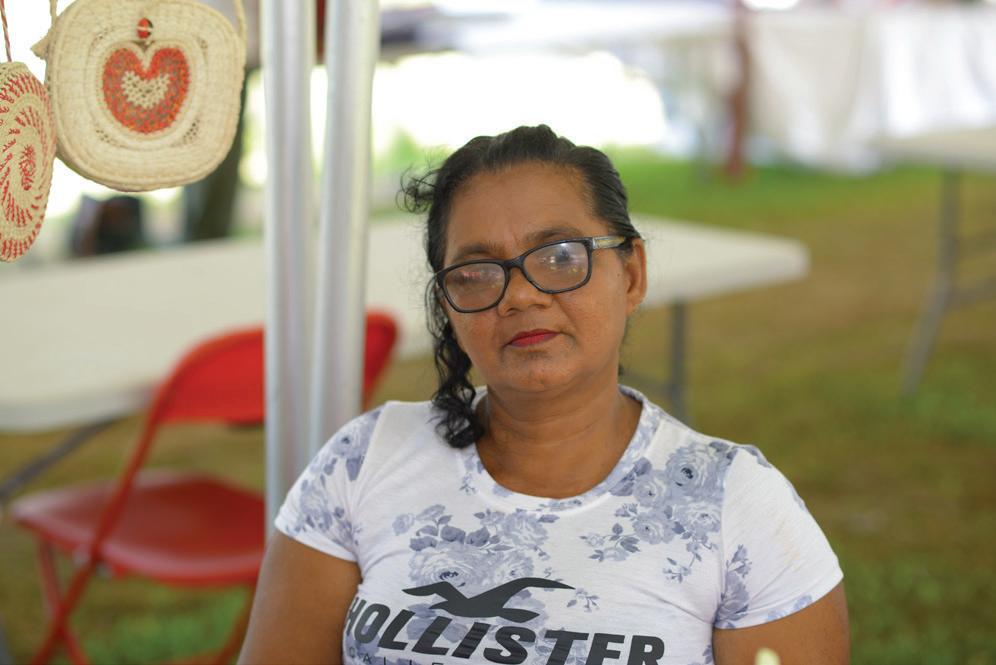

Taylor has been participating in exhibitions since 1995 at the Umana Yana, and some of his pieces were an absolute attraction at these ‘expos’.
He reported that wood carving is a long process, firstly, to select the best wood, and that he gets his ideas from travelling, nature, and old stories from his ancestors.
Taylor would also like to see the schoolchildren get transportation to and from Rupertee
Exploring Entrepreneurship A young woman’s blossoming business
 By Shaniya Harding
By Shaniya Harding
LOCATED on the ground floor of Palace De Leon is the aesthetically captivating boutique named Lavender Creations. This little establishment is interesting, with its custom-made cups, crocs, bumper stickers and one-of-a-kind tee-shirts.

But the story behind it, and the impressive 18-yearold woman that owns it is just as interesting. Lavender Creations began sometime
‘COVID’, and I just tried sewing something. And that’s how I started. I was going on YouTube and looking at headbands and different stuff like bonnets and scrunchies.”
Like many businesses born during the quarantine, Sharecia’s creation initially gained traction on social media, specifically Instagram. After she was flooded with various customer orders and requests, she turned to the support of her father. As she stated, “My father helped
other people in the field, and going to ‘expos’; I just love it.” She emphasised that support for small businesses by other small businesses is vital to the development of all entrepreneurs in Guyana.
The name Lavender Creations, Sharecia says, has a very simple but deep meaning for her. As she stated, “My favourite flower and colour is lavender. So that’s where the lavender came from. And the creations, because I like creating.” Her love for making
in my bag, I really had to figure out time management, and how to focus on school and the business. But as the years went by, I got better with my time; I grew the stocks and the capital. The hardest part was just getting started.”
On marketing and customer base, Sharecia says that clothing and custom-made items are what many people look forward to. “There are a lot of customers in the field in terms of clothing, that’s why
during 2020. As the owner states, its first product was made entirely out of boredom. “I didn’t want to open a business at first. I started this business four years ago, when I was fourteen. It wasn’t me wanting to open a business, but I love doing creative stuff,” Sharecia Moore said.
Sharecia expressed how, after her first product, a handsewn bonnet was made, it opened doors for her creativity. Lavender Creations’ biggest supporter base, from the get-go, was her family. They were the ones who bought her first products, encouraged others to and believe in the young entrepreneur.
Sharecia was just a fourteen-year-old stuck at home from school sometime in 2020 due to the pandemic. Sharecia stated that at that age, she didn’t want to create a business; she simply wanted something to do. “I was bored at home during
me buy a sewing machine, because I hand-stitched the first ones. But for professionalism, I went and got the machine and the cloth.” She went on to talk about the days at school when she would have her mother buy things for the business while she was at school, and she and her father would venture out to make deliveries at night.
With the expansion in the capacity to create, Sharecia saw her creative abilities blossom. She began making more products and thinking of new ideas. “I just love bringing this creativeness to things,” she said, adding: “When people come in, they would say, ‘This is so cute,’ but I like putting things together, and putting it out there.”
The small-business field, she says, although hard to break into at times, is still a very interesting experience. The young entrepreneur said, “It’s so amazing meeting
something out of nothing is also what pushed her to craft custom-made items, based on what her customers want.
There are challenges in owning a business, but those issues were amplified for Sharecia. Today, Sharecia is pursuing a degree in Business Management and Marketing, but she says in the early years, balancing school and business was not what she’d mastered. “It was hard, because I couldn’t do much investments. Because I was going to high school, trying to focus on CXC, I didn’t have much capital. That was the hardest part; trying to figure what I can do with what I have,” she said.
Sharecia often found herself being spread thin between getting entrepreneurial endeavours and school. As she said, “Time management is another thing I struggled with. Although I looked out together in high school, coming to school with my orders
I am expanding there. The customer base is there.” She went on to share that, “There are glasses and tumblers that are plain right now, but you can have your name on it;
flowers, anything you want.”
To other small business owners, Sharecia emphasises the importance of hard work and being your authentic self. As she stated, “Even if you think it’s not going to kick off, because it is very slow in the beginning. Even if you don’t believe that is where it is going to go, even if you don’t see the vision yet; you just keep putting in the work. And just keep being a hundred percent you in your business and that’s going to
take you a far way.”
Lavender Creations offers everything from delivery to custom-made bumper stickers. Sharecia, in describing Lavender Creations, calls it, “A business that brings stylish and unique products.” As for future plans, Sharecia shared, “I hope Lavender Creations will grow into being a very recognised brand, not only in Guyana but further afield.”

Local tour operator passionate about promoting Guyana as tourism product
 By Michel Outridge
By Michel Outridge
JAMAL Thomas is one of Guyana’s local Tour Guide/Operators. He has a wealth of information regarding tourism and taking people to places in Guyana is a ‘walk in the park’ for him, since he is passionate about his job and presents many facts to visitors and locals seeking an adventure.
Thomas has been in the tour operator’s field for more than 11 years, first with Evergreen Tours and then with Old Fort Tours. A year ago, he established his own tour operation and is now living out his passion through his solo venture.
His service is “Exclusive Adventures” and like its name, it entails exclusivity. The business is a licensed company registered with the Guyana Tourism Authority (GTA) and has all the safety requirements in place, as well as training.
Thomas provides tours to all parts of Guyana such as Essequibo, Linden, Berbice, the interior, Bartica, the Kaieteur Falls and also overseas, including Brazil and Suriname.
Thomas reported that he hopes to expand his tour operations, but for now, it is just him and he manages quite well and never gets tired of travelling and going to the same places repeatedly.
“I really like what I do for a living. I’m inspired to show people Guyana and being able to interact with them is everything. Learning about different cultures and being able to speak about my country is my dream job,” he said.
Thomas came from an accounting background and then switched to Sales and Marketing and eventually took a distinct liking to being a tour guide and realised he had found his niche.
“I like to show people what Guyana is all about. We have a unique tourism product, unlike other countries. Our tourist destinations are set in nature, real picturesque places, the historic sites and it’s not all about lakes and blue beaches; the experience is real and it is nature at its best,” Thomas said.
Thomas added that Destination Guyana is as real as it gets and we have so much to offer
as a tourism product and our eco-tourism isn’t talked about as it should.
The tour operator/guide told the Pepperpot Magazine that his prices (packages) are pocket-friendly and include lunch, snacks and beverages for day trips.
He disclosed that he doesn’t have an office but is active on social media, Facebook, WhatsApp and Instagram, where he advertises his small business as a tour operator/guide.

As he is well known among his peers and others, Jamal is a very outgoing, friendly person who is very enthusiastic about his job and he is definitely an outdoor kind of guy who appreciates different foods and in any portions.
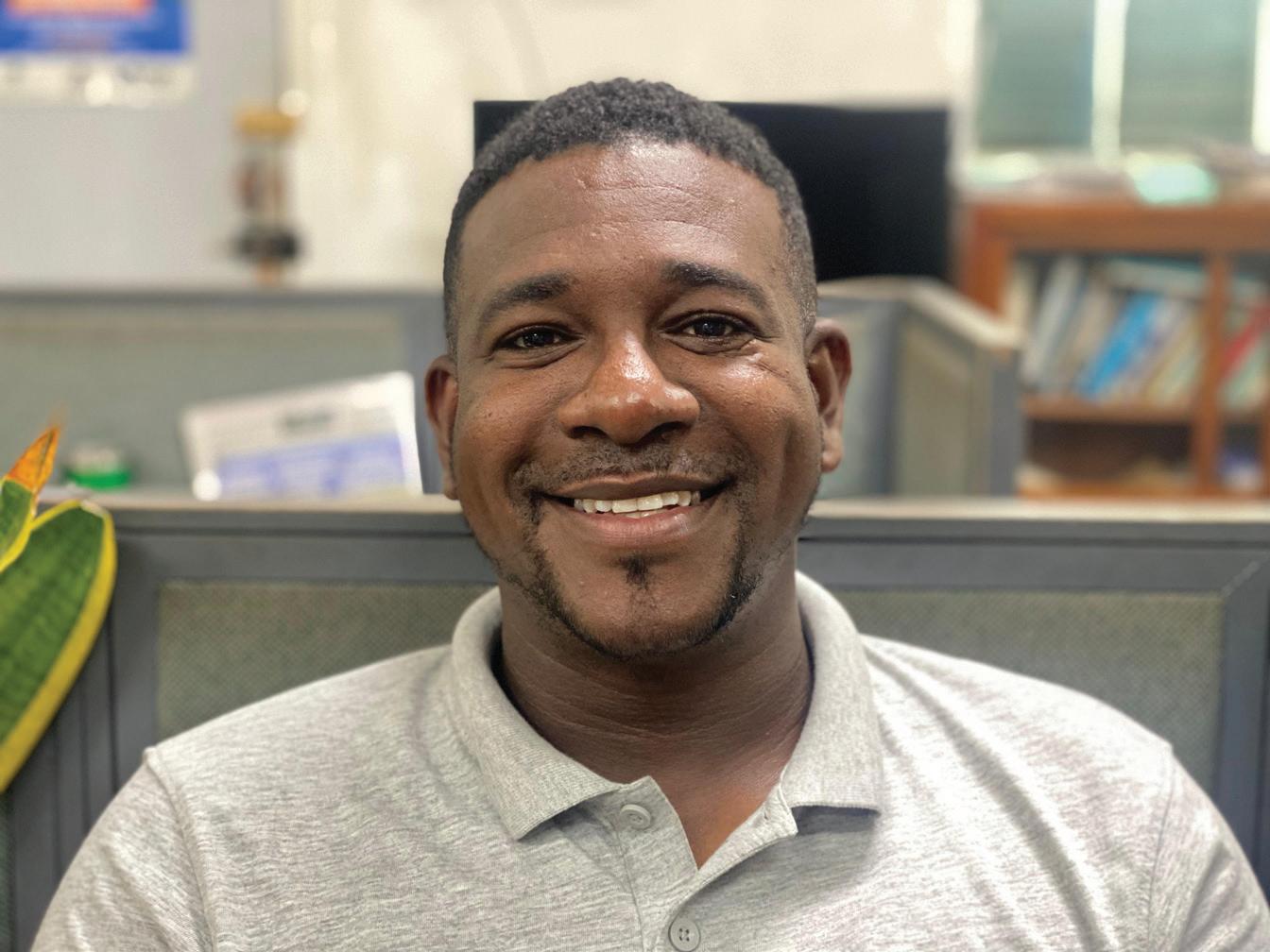
“I would not get tired of my job, never, and it is something that keeps me going and within the past five years, we have seen a boom in the tourism sector in Guyana, so business has been good,” he said.
Thomas grew up in Charlestown, a city boy who relocated to Eccles, East Bank Demerara and knows a lot about Guyana and tourism.
Exclusive Adventures is for both locals and visitors and it is an experience that will leave you overly satisfied and saturated with information about Guyana; so don’t hesitate to book that trip to experience Destination Guyana.
Saluting Teachers World Teacher’s Day 2023
ON October 5, every year, the world observes “World Teachers Day.
It is a Day where teachers of every capacity, but particularly those in the public and private systems, are honoured for their sterile contributions to the educational sector over the years.
This year, Pepperpot Magazine visited Paruima, an indigenous village of Pemon Amerindians in the CuyuniMazaruni Region of Guyana.
The village was founded as a mission of the Seventh-Day Adventists.
The team spoke with Sandro Edmund, who has been teaching for 10 years now.
He shared that for him, teaching calls for great commitment if you are going to reap great results.
“I have been a teacher for about a decade nowand I have learned that being a teacher calls for 100 percent commitment to the profession in order to reap good results. Unfortunately, I find
myself falling short of that requirement.Nevertheless, I aspire to improve,” Edmund said.

Edmund noted that there are joys to be experienced in this profession and moments that bring satisfaction to your heart as a teacher.
“When I see the faces of children light up when they discover something new during the lessonthat is being taught to them, I find that very fulfilling, knowing that it is something that will always remain with them”, Edmund said.
The Paruima teacher also finds joy when he sees children that society may consider “slow learners” excelling in sports, gardening, and music. It just shows that every child is competent, he explained.
But yet,Edmund satetd that another big joy comes when children become successful at the National Grade Six Assessment (NGSA).
“Finally, it is a great joy
to watch children gradually mature and move on to higher learning institutions and later come back to serve their communities,” the teacher noted during his interview.

Edmund shared that no profession is without its challenges and hurdles, so naturally, he has faced his fair share during his career.
“It is always saddening to see some children coming to school without having breakfast. It’s painful, and hurtful, especially knowing that you can do nothing to help the situation. It is my hope that one day we can collectively find a solution for this,” he shared with the magazine.
Edmund admitted that it’s also quite intimidating to work in a female-dominated profession. According to him, male teachers are rarely found in schools and that’s perhaps because of their inability to be patient enough with the children. He noted that even though he may not be patient enough with the
‘Arts and Craft...
FROM PAGE II
to Annai, some two miles away.
He explained that the terrain is rugged, and the children are left to the elements when walking to both the primary and secondary schools.
Taylor said that the population of Rupertee is about 400, and their main economic activity is farming, while the cost of food items is substantial.
WOODEN CRAFT
Patricia Goveia hails from Santa Aratack, Region Three (Essequibo Islands-West Demerara), and she has a craft shop in the village where all the local artisans bring their products to sell.
The 52-year-old told the Pepperpot Magazine that in her shop, they sell all categories of arts and craft, and she specialises in ornamental wooden craft.
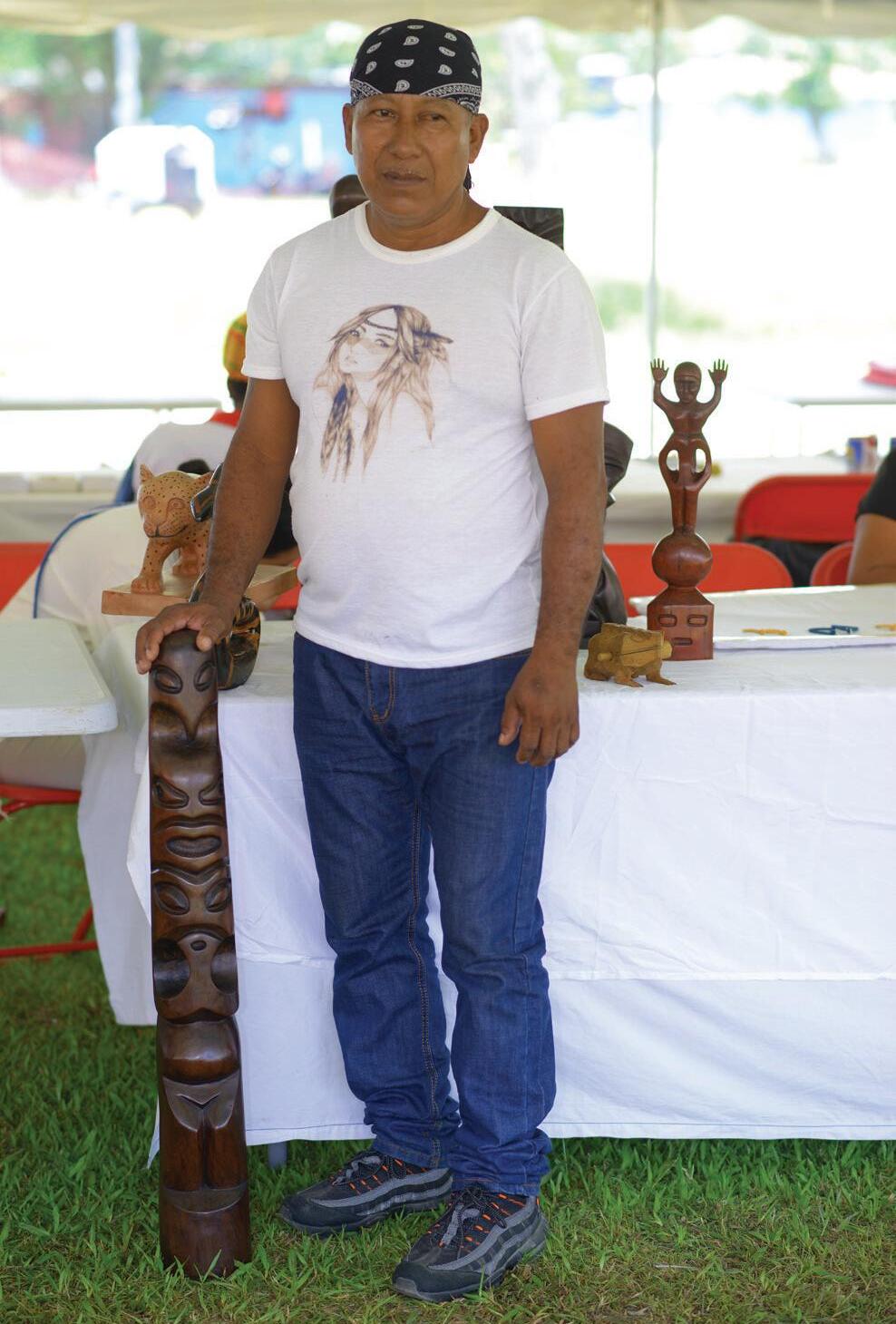
She is originally from Bartica, and has been into craft making for 25 years for ornamental purposes.
Goveia is the mother of eight, and she feels really
good when people buy her pieces to take away to be a part of their home.
Valentine Stoll is originally from Pomeroon, but relocated to the Essequibo

and
Coast. She is 64 years old, and is an artisan who is a wooden sculptor with some interesting pieces depicting
SEE PAGE XXI
Sandro Edmund has been a teacher for 10 years
children, he doeshis best in the circumstances.
“I have always imagined having an actual class-
room where there will be less noise, more concentration, and classes that are easier to manage. It is quite a chal-
lenge to put up with a whole auditorium that is barely separated by makeshift walls,” Edmund said.
He cited that a challenge he finds in the classroom is the inability of pupils to connect with the outside world when they have never been exposed to it. It would be a great idea, he believes, for the Ministry to organise tours for the hinterland children on a yearly basis.
“All in all, I must say that it is a privilege to be a teacher and I do not regret being one. We just ask for the continued support of all the stakeholders in the education fraternity so that we can provide a wholesome education to the children we dearly love,” Edmund said.
Melanie Damishana
MELANIE Damishana is one of those villages that just can’t go unmentioned among the interesting places in Guyana. The name Melanie is popularly known to have been given by former president Forbes Burnham, being named after one of his daughters. Whereas the word ‘Damishana’ is Swahili for simply ‘village’. The development of Melanie was unique. It was implemented by the then government and president. But it was built by the everyday man’s blood, sweat and tears.
In places like Rodrick’s Lane, on the North side of Melanie, the houses were built by the villagers. It began with a team of 10 men and two women, who worked together to build house after
house, eventually cultivating a community. Melanie’s village is unique in how it was developed and the idea of



what it would become. The village of Melanie could be found immediately after the Nonpareil turn. The village is made up of the north and
south sides.
The south side was developed first and the village later crossed the road into the north side. Melanie lies among villages like Enterprise and Bachelor’s Adventure. But the community feel could be felt and seen in the very people. Anne Roberts was among many to build via ‘self-help’. This term may not be common to many of today’s people. But to Anne and the folks of her time, it was one of the few, cooperative ways of acquiring a house.
It was a creative way of developing neighbourhoods. It was a system in which all the members would build a number of houses, one after the other. And then the houses would be given to each participant. “Soldiers came here first,” Anne told the Pepperpot Magazine. She described how the land was allocated and shared out to who were considered public servants, saying, “Then pub-
Several buses were the means of transportation for the people involved in the self-help movement. These large buses were often so crowded one couldn’t sit and they would traverse the streets to collect people in the wee hours of the morning.
Anne remembers these days when she and other persons would get up to take the bus that would take them to begin the day’s hard work, saying, “About two or three trucks would drive around and pick up the self-help persons.”
“They had areas that had trucks. At that time, I was living on Durban Street. And I would come out at the corner of Durban and Vlissingen
though cooperation, especially on a large scale was much easier to find some forty years ago. “There were days when we had to go to Hope estate to volunteer,” Anne stated. She went on to explain that they would be given ration for their hard work and effort. “We would get a little ration. We would go to the office and collect the ration. But it was a must we had to go and collect it,” Anne said. Its collaborative and cooperative past still has a very prominent impact on the Melanie of today. Many
lic servants, like nurses and people who worked in offices and so on.”
The houses built in Melanie in the early years were flat houses. Looking around the village today, many of those original houses could still be found. “It hasn’t changed,” Anne stated. “Only the paint may have been changed. People do over their houses, but here it was just those three-bedroom houses and flat houses.” The process of building a community was an arduous task. Most of the people that originally came to reside in Melanie came from far and wide. Anne herself hailed from Georgetown.
Road and wait for the truck.”
Anne further shared. The self-help initiative was very developed and incredibly organised. It valued time and effort. And as Anne explained, a number of houses had to be completed by a particular time. “We had 28 houses to finish at one time.”

Anne stated. That was the quota the group had, and, like any good worker, the team worked overtime. ‘We had to work from in the mornings when we reached up here to ten in the night to complete those 28 houses for the opening day,” Anne said.
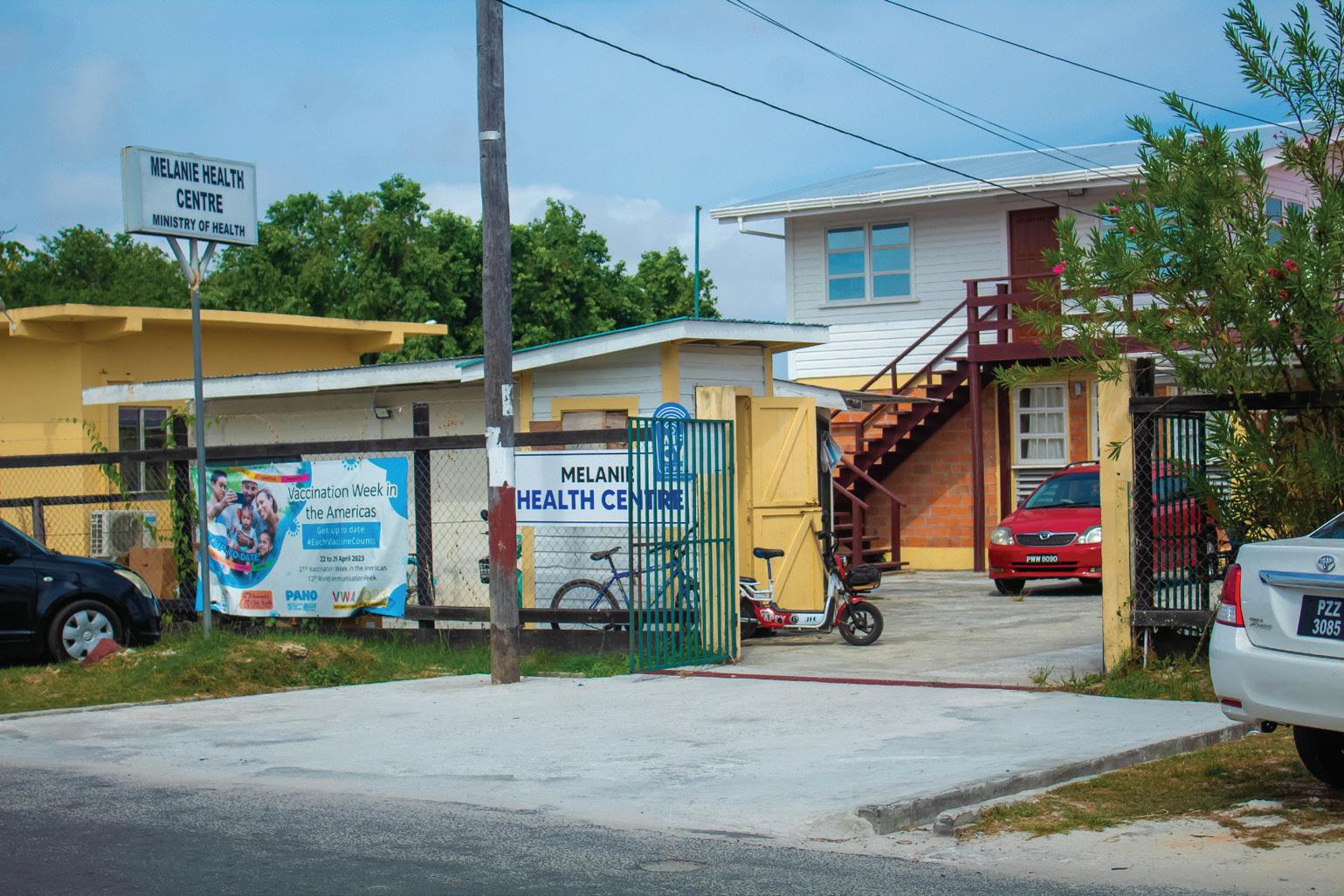
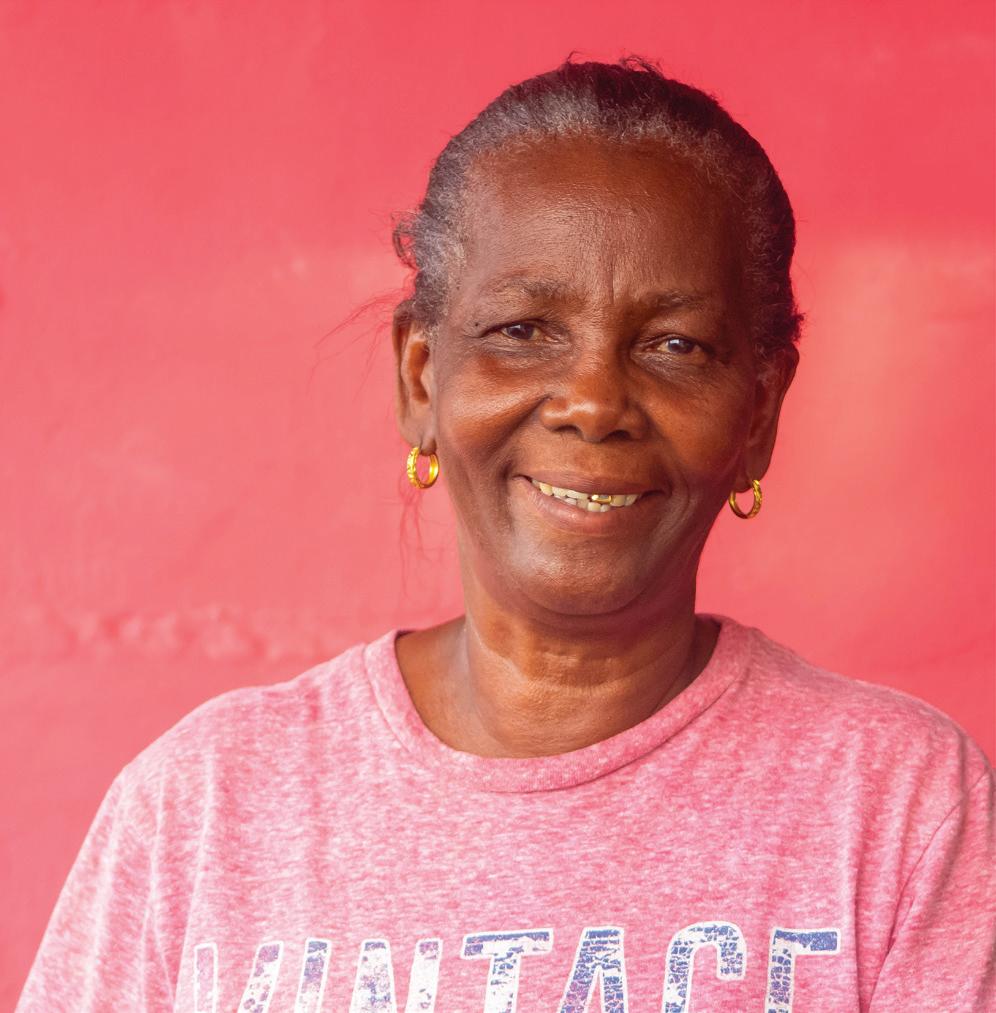
Hearing from the people of Melanie it would seem as
of them are proud of the fact that Melanie was built by its people. When asked how she felt about her community, Anne simply said, “Living in Melanie nice.” Anne expressed that the people, peace and quite are some of the things she loves about her community. “But Melanie change now. It’s not Melanie anymore. The place is neglected and the behaviour of the youths. It was more peaceful,” Anne said. But whether today or five decades ago, Melanie is a beautiful and happy place. And home to a strong, beautiful and happy people.
Melanie
The village of Brotherly Love
 By Shaniya Harding
By Shaniya Harding
THE village of Melanie, located on the East coast of Demerara, is a mere 30-minute drive from the capital city. The village has a past rooted in cohesive cooperation and support.
At first glance, the village seems to lack a difference from places like Georgetown or other communities considered city places. But upon spending some time at any given cor-

ed as one of the friendliest people in the village, owns a shop. She shared that, “I have lived in Melanie for around 40 years now. Melanie is so wonderful. It is a quiet place. The environment is good. The people are nice, Melanie has nice people.”

Janett ventured into the village of Melanie many years ago. And from that time to the present, she says Melanie doesn’t quite look how it used to. She said,
anymore.”
Like many people who fell in love with the aura of Melanie, it wasn’t Janett’s intention to live and later love Melanie. She originally came to the village because of her work and family. “Melanie was close to my workplace. I got married, and I came to live in Melanie. I used to work in Paradise at the regional office. And I left the job and come to live in Melanie because of my children.” Janett stated.
on the whole. Everybody would come and buy to put in their children’s lunch kit, bag or whatever. It was a little shop and I increased it until it got to this size,” Janett said.
The impact of Forbes Burnham could still be felt in the very base aspects of Melanie. When asked about what she remembers about the Melanie of old, one recurring factor was that of the village’s founding father. “We used to call Forbes Burnham ‘Kabaca’ at that time. We used to say Kabaca coming. That was the term. Everybody would use that term.” Janett stated. And the name, of which it’s origin is unknown, held plenty of weight.
Unlike the sentiments from other villages featured, Melanie
reports an apparent decrease in its population. As Janett explained, “It’s not so populated to me like when we had the post office and the bank. We had all those things and it was more populated. Everybody hustling.”
She went on further showcasing that the hardworking and progressive nature of the people of Melanie has never faulted. She said, “Some of them farm, some of them do woodwork and make furniture and a lot of them are tradesmen. And most of them do taxi work. “These days Janett spends a large part of her life gardening when she’s not tending to her shop. She shared, “I plant everything, I plant my little kitchen garden and flowers. I like planting. It is like a hobby. ‘When asked about what she loves about Melanie, it is the same thing that draws many people in.
It’s an authentic community comradery feeling. She said “Just the quietness and the simplicity. Not too much of rows and an environment with no fighting. It is just peaceful. We just live quiet and humble.”
On the matter of why she believes Melanie has managed to remain as such a close-knit place, Janett said it had plenty to do with its humble beginnings. She stated that, “Maybe because it was a co-op. It was a cooperative with everybody. They used to coop to build the houses. We used to jump on the donkey cart to get materials to build our houses. Friend will help friend, and neighbour will help neighbour. Melanie, Janett said, is a special place, “We have this kind of togetherness.” she stated.
ner shop or street corner, one can deduce that Melanie without a doubt has a rather simplistic village, almost country atmosphere to it.
Janett Rugby came to live in Melanie many years ago. And although much has changed since then, one thing never lost is Melanie’s unity. Janett, widely regard-
“It has changed up a whole lot. We have a lot of big houses. “The rearing of cattle and livestock was once among the major economic activities of the past in Melanie. But that is one part of the past that has seemed to dwindle. As Janett stated, “We used to mine a lot of stocks, but we don’t do that
One of the many notable aspects of Melanie is its affinity, more so than other places, for businesses. Janett expressed that opening the business was also a faithful occurrence. She didn’t intend to open a business, but it developed nonetheless. “I used to make snacks for the children and the community

Melanie’s next Generation and the role they can play
By Shaniya Harding‘PLAZA STREET’ is a term and place familiar to every villager of Melanie and even those from neighbouring villages. Plaza Street can be described as Melanie’s own village centre - an avenue lined with a number of businesses and bars. It is a
focal point for many of the village’s celebrations and the place comes alive when the community comes together.

The plaza was built under former president Forbes Burnham. It was among Guyana’s first malls and it profoundly impacted the community and the country at the time. Today, all that



remains of the once spectacular plaza is its name and the street on which it once was. But its influence on Melanie’s people could still be felt today and many wish it could be recaptured.
Sherwin Moffatt began his childhood in Melanie. Today, he works on Plaza Street and one of its many hotspots. He first came to
live in Melanie with extended family amidst issues between his parents. He said, “My parents had some problems and I had some cousins here. And it was me and my sister that came to live in Melanie.” Melanie was once breathtaking as he remembers it, and the plaza left his young mind awestruck.
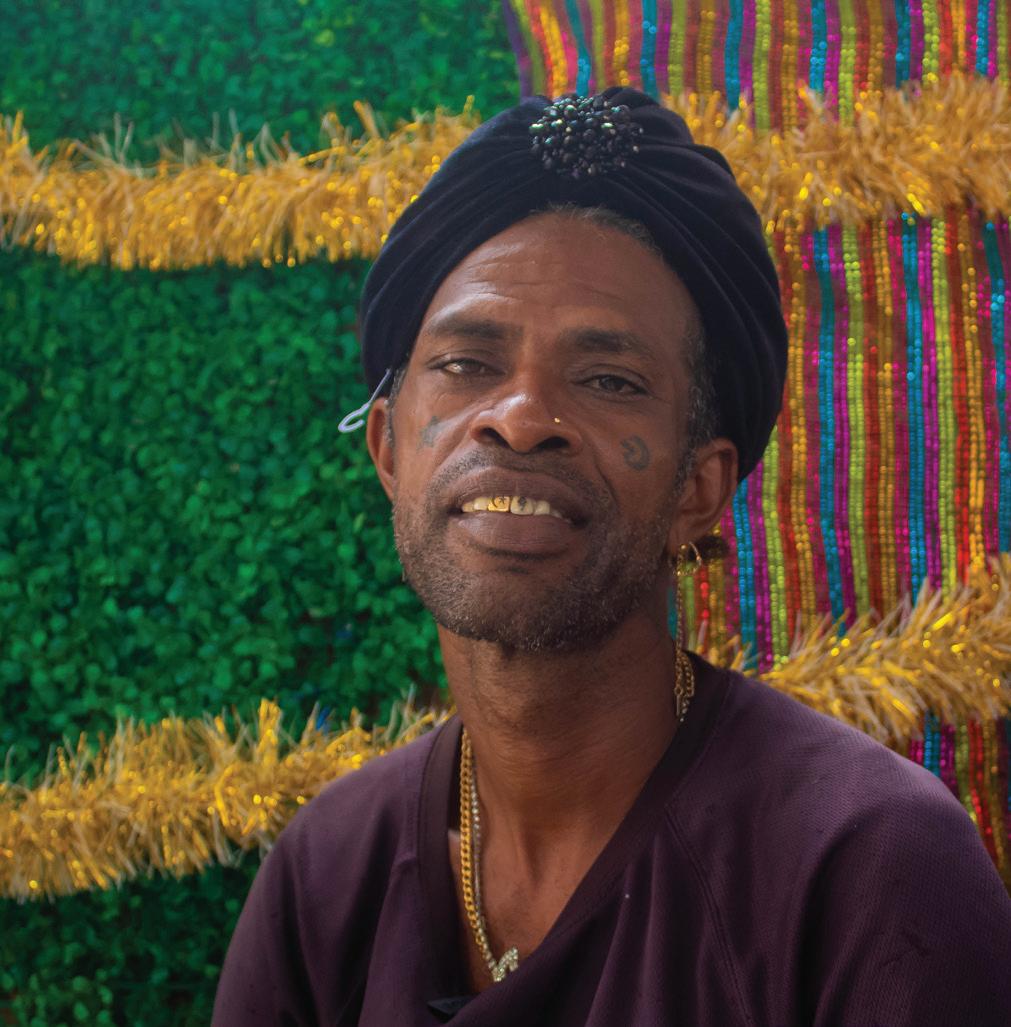
“At night in Melanie the place was so nice, because it was right next door to the plaza. In the night the plaza would light up,” he said, likening the village of Melanie to a foreign place. “I thought it was New York I reach when I saw the night in Melanie. The place was beautiful,” Sherwin said. Melanie’s unity is said to be in its very roots and humble beginnings. The village was formed by hardworking Guyanese people cooperating through self-help initiatives.
Today, the village still has a co-op where many things in the village are done by its residents. Sher-
win said the co-op was an impressive effort no doubt. But he would love to see the involvement of more young people. And for young people to carry on the baton, the older generation has to hand it over.
“The elder people that
are in the co-op need to come out and go through the alleyways in Melanie. They are only focusing on the front drains and the side drains, but through the alleyway nobody is going and
The Importance of the Past Local history enthusiast on the relevance of history
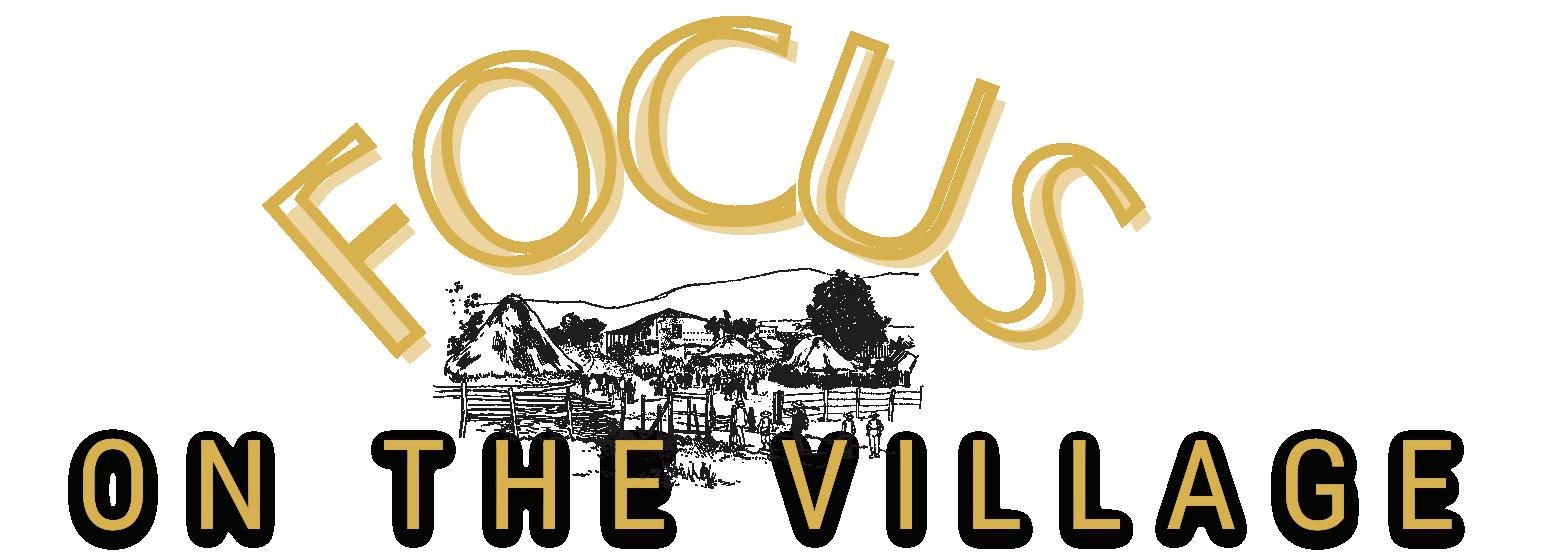 By Shaniya Harding
By Shaniya Harding
HISTORY and the past are of little importance to many, facts to some, but it is vital to very few. David Joseph is one of those few who see the past as significant as the future. David has dedicated the latter part of his life to research. Apart from being a reservoir of knowledge from Melanie’s past, he also has a particular spark and passion for African history. David’s interest in African knowledge was, like most things in his life, connected to the village of Melanie.
Melanie was founded as part of a ‘Feed, Clothe and House’ initiative. “The government had an FCH project. That is feed, clothe and house the nation. It was one of the programmes they had and I believe it started sometime in the seventies.” David shared. The programme was rolled out country-wide. And many villages at the time had to play a role in some aspect of the campaign. “Kimbia was the cotton for the clothing. Mahaica Mahaicony Abary that was the rice. That was the feeding. And hence
Melanie was the housing,” David shared.
David went on to explain the land which houses Elizabeth Hall was among the first land acquired. “What the government of the day did to get a house, you had to get land. And the government went to Guysuco for the land. And the land they were given was block thirteen, Elizabeth Hall.” David said. David comes from a large family and having his own house was something he worked towards. He said, “I came here in 1975, but I moved in 1979. What led me to live in Melanie was not really a desire of mine. I come from a big family, eight boys and eight girls, then.”
“I dropped as number 13 out of the 16. I joined the army on October 4, 1972. I spent some time in the interior, in the Corentyne and Essequibo,” he recalled. It was during his time in the army that he had the opportunity to work and later live in Melanie, and he took it.
“After this housing drive start with the FCH, I was in the army at that time as
a construction engineer, and they wanted tradesmen and they chose me. After the houses reached a certain stage for wiring, so that is how I came up here.” David came to Melanie and was 10 and was given the chance to live in the village via Melanie’s co-op.
At the time of the co-op and the initial stages of the village, there weren’t many people, places or houses to talk about in Melanie. “At first, I think they had twenty-seven houses. If you go down Linden Drive, what we call Plaza Street, I think those houses were built but they had no other houses built. But nobody moved in yet, so all around was empty land.” David stated.
“We had to join the Co-op. You had to be a member,” David stated. “At that time, I think it was a dollar or two. Because at that time, our money was very small.” It was this share capital that built not only the village but also its renowned Plaza. As David explained, “You had to take out shares and the share capital, according to the members, had to go into
the investment of the shopping Plaza. The members share capital is what built the shopping plaza.”

The development of Melanie was no walk but the end result, David said, was worth it. “It was a national venture as a cooperative Guyana. It was rough like anything else. But the end product was that you received your own home.” Like many organisations and systems through the years, the co-op had its issues, and it later partnered with the Ministry of Housing “There was a problem in the co-op in 1979. And what the government of the day did was get the co-op officer at that time to appoint housing to manage
the co-op. They managed it from 1979 to 1997, about eighteen years.” David shared.
In the years that followed, there were a number of disturbances regarding the allocation of land in Melanie David said and it was his urge to get to the bottom of the true history of Melanie that ignited his passion for research. David’s affinity for African history research began after a friend offered him a book that was meant to be thrown away. “I started doing African history when I wired Fogarty’s in 1991,” David said. He went on further saying, “This was amazing; while doing it they threw out William Fogarty’s books.”
The things he learnt, he says, changed his entire way of thinking. “My father was a preacher; he had his own church. That how all of us came up, in church. I grew up in catholic church.” David sated. Thus, his sudden exposure to a whole host of different cultures and history, was life changing to a young David. As he stated, “The largest section in the library was African history. It was then that I knew that Africa has 54 countries.” The things he was able to read and learn, David said, shaped him into the man he is today. “It changed my whole life because I never knew about it.”

Commemorating the sacrifice of the Trans-Atlantic Slave Trade with a deeper awareness
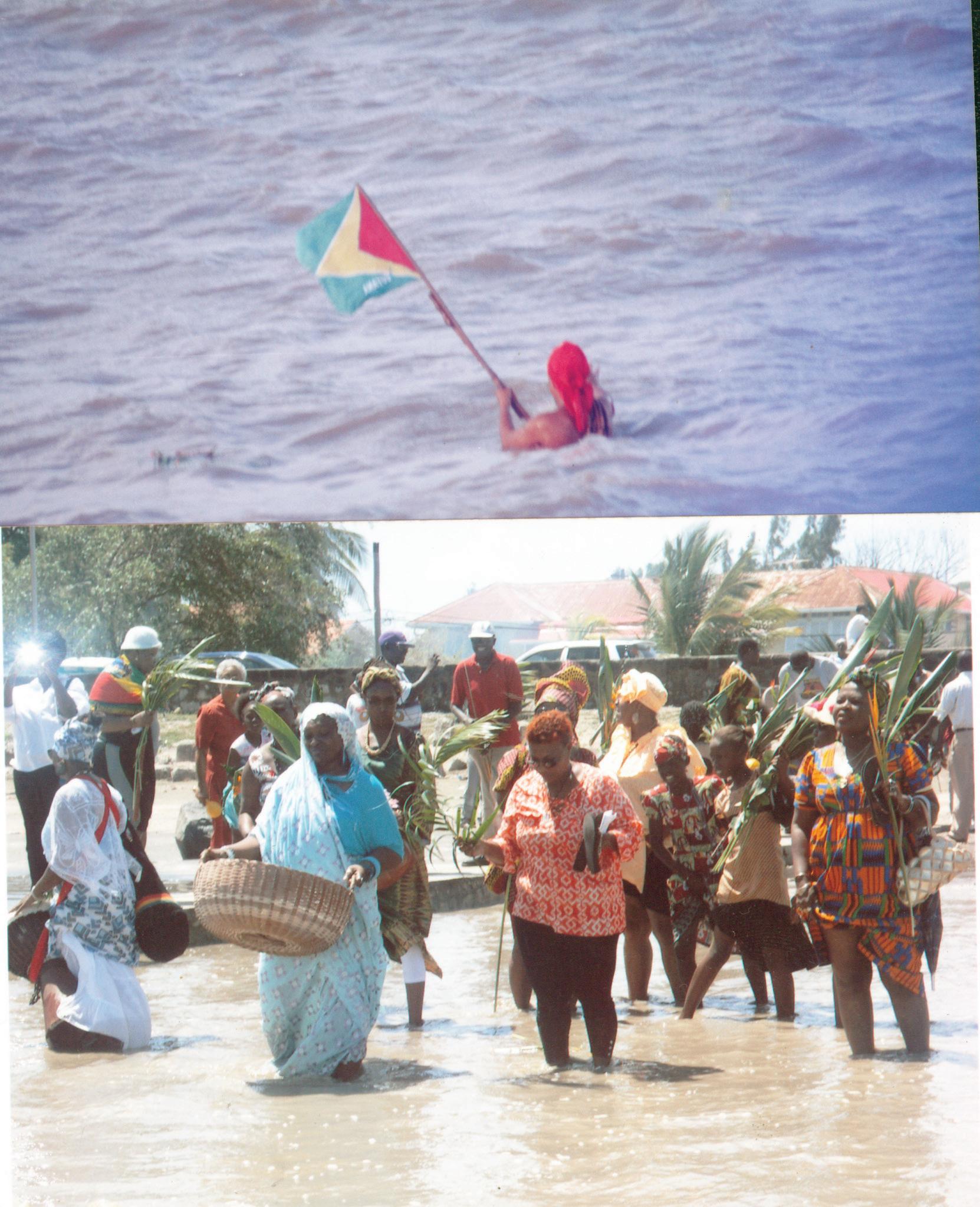

NO commemoration that records human suffering is complete without a broader awareness that expands to explore the shades and shadows that are gathered to hinder clarity and closure to the reasons ‘WHY
and HOW’ the acts that are now memories were created in the first instance. What did our ancestors do to merit this treatment?
If we look at African history, we can summarise from the items we locate
that we were probably the citizens of potential vassal kingdoms whose conquests demanded the prevention of layers of remaining peoples and related tribes that could rebel against the imposed status. The fall of the
Kingdom of Ghana (not to be confused with the modern state of Ghana) in the Sudan, when vassal states converted to Mohammedanism, especially led by the Almoravid Movement, brought into the Sudan by Berber Arabs, to which the vassal African kingdoms found a useful philosophy towards unification against GHANA, 1042-1054 . See-Topics of West African History by A.Adu Boahen.
So far, we do understand that the system of enslavement in not new; it is an ancient system of exploitation, but however, the slavery conducted against Africans in the era of the Atlantic Slave Trade may have been somewhat different in that both Christendom and Mo-
hammedanism used religion to justify slavery against Africans. Twisting supposing religious text to justify slavery on racist terms, in current Guyana, most religious groups led by African descendants, defining themselves as Christian, have demonstrated no inclination to explore past religious and philosophical theories, and to point those original injustices towards the guilty, much less even discuss that era. Regardless of the documentation that now exists, they seem quite comfortable where they are socially. This article will explore the terrible process that embodied the journey into bondage. One must understand that our ancestors were not enslaved when sold to the Slave ships; they were
sold into enslavement upon arrival here. The journey of new captives into slavery constituted an on-ship uneasiness from ship crews, which employed the skills that the slave ship crew learnt from many journeys. Africans had no desire to leave Africa. Thus, on ships, rebellions were common, as well as suicides. And this also could be traced to tribal origins and pre-capture occupations. The African people brought here knew secular institutions common to past eras of tribal sustenance that benefited the commerce of the enslavers. For example, Henry Bolingbroke (17991806) indicated that Europe-






Surviving Guyana’s Sun
I HAVE been describing the sun and heat. We’ve been experiencing the heat in so many adjectives lately that I can’t seem to keep up with myself. The place is notably hotter than usual. We’re used to those tropical breezes with the sun out, just enough to feel warm and comfy, but the heat we’ve been experiencing lately is far from that. I have found myself panting for breath, sweating profusely, and feeling lightheaded. I tend to get exhausted more than usual and working in these environments without an air-conditioning system and/or proper working fan is a dangerous “sport” to play. We aren’t living through it. We’re trying to survive it. It might sound exaggerated, but can you imagine what it must be like for the elderly and children as well? Or, how about those who can’t afford electricity and depend on a crack in their windows?
Everybody has their fair share of how the heat affects them and their daily lives--some may have more effects than others. Nonetheless, you should always remember to stay hydrated. Water is essential during these heated times. You may have to drink more water than usual, but it’s still the most effective way to prevent physical fatigue. You can also avoid extra heat sources such as gas ovens, certain light bulbs, and heat-related home appliances. You can also try cool baths or use damp rags on your head to “cool” off. A nice icy bath sounds really good right about now for most of us, I am sure of it. Lastly, you should be aware of how to recognize certain health-related illnesses. They aren’t to be taken lightly and I urge you all to understand what they are—heat rashes, heat stroke, heat exhaustion, heat cramps.

Apart from us doing our individual parts in ensuring that we cope and manage in the heat, our policy makers also need national responses. It may sound silly, but most of what we’re experiencing is the result of global warming. It’s no longer a text we read from books or newspapers; we’re experiencing its effects all around and it should not be ignored. Not every public building is equipped to handle the heat of our regular temperatures, much less increasing ones that may arise. With the intense heat comes frustration, exhaustion and fatigue. Even with the temperatures now declining, how can we handle such a phenomenon yet again? Are we even prepared for what’s to come as it relates to very dry seasons and its effects?

Recently, in New Amsterdam, there was smoke pollution from the town’s dumpsite that was set ablaze. The fire got out of control and it is my assumption that the very dry season and lack of rainfall caused such a thing to occur in the first place. What systems are in place for the agricultural system, specifically small-scale farmers with rising temperatures and no rainfall? These are all things we ought to keep in mind now and for the future. Some days the sun can be our friend, but on other days, its extreme heat waves can impact our quality of life tremendously. As such, we have to keep abreast with ways in which we can help ourselves, help others and also sustainable ways in which we can also help our planet in the process. We can survive this heat together, we just have to work together to do so.

PLANT A PINK ROSE FOR ME
THE woman, fair with slight oriental looks, stood alone at the top of a hard mud dam. She was not like the locals, a stranger from a foreign land, not lost, but there with a purpose.
Angela was her name, an Indo-Guyanese, mixed with European, Scottish and Chinese ethnicity going all the way back to colonial days.
“Interesting, our history,” she had always thought while growing up.
She took a deep breath and looked around the cemetery, a place where the grounds she had never walked but a place she knew in her heart she would have had to visit one day.
She had left the shores of this former British colony since she was a young girl, returning now after thirty years.

“Such a long time,” she mused, “Seems like a dream that I’m actually here.”
As the years had gone by, living in a new country, she had nurtured in her heart the desire to come back home to visit. She wanted that nostalgic feeling of being home, to feel the thrill of a place she had never stopped loving. But she got no support from her family, whose main goal was to build a life in a foreign land.
“I will find my way one day,” she had promised herself.
Now an adult, divorced and self-independent, she finally fulfilled that promise to herself. But sadly, there was now another reason for the trip.
She walked along the dam that was alongside a side lane with flowing brown water sugarcane plants stretching from its bank to the far horizon. She stopped once, looked around a little uncertainly then continued walking and a little while later, she saw the gravesite.
Emotions she had kept in control for years, rose slowly, sending a tremor through her body. She took a deep breath again and said quietly, “Hello, Nani, I’m here.”

Her grandmother had died ten years ago and her ashes flown home from
America to be interred here because she also desired to return home. Angela has missed her so much, her precious memories giving her the will and strength to go on with her life, always winning battles.
But unexpectedly, a major battle appeared from nowhere and blindsided her.
Breast cancer!
That diagnosis had hit her so hard that it had left her mind numb and her only thought was, “Oh God, I’m going to die soon and I haven’t gone back home yet.”
She had thought of her Nani and somehow found the mental strength to pull herself up, one day at a time.
“This is the battle of my life,” she had told herself and fought hard through treatment, holding onto positive thoughts and hopes to live for each new day.
She sat there, now in the cemetery, in reflections, passing her hand slowly over the tomb.
“You were my everything from the time I was born. You never left me, then migration separated us until you came there too, but years later death took you away.”
A lump formed in her throat, overcome by emotions and after a while, she said, “I couldn’t say ‘goodbye’, Nani, wishing now just to hear your voice and your laughter, and watch you work on your vegetable garden.”
Tears filled her eyes, remembering those wonderful days, and she voiced, “But you know what, I’m here now, close to you, close to everything I loved and that is all I need for everyday I live from now on.”
There was a light of determination in her eyes and in the tone of her voice, “Stay with me, Nani.”
A cool gust of wind blew across the cemetery and Angela smiled, a happy feeling surging through her body. She hadn’t had that feeling in a long time, not that enthusiasm. The cancer in her body had been diagnosed in time, giving her a fighting chance of surviving. But there were
A focus on language

ABOUT two weeks ago, I attended the Ina Maimu Yetatokon panel discussion hosted by the Amerindian Peoples Association at the Marriott Hotel in Kingston, Georgetown. It was a space where various Indigenous persons spoke about issues affecting them and their communities. One presentation in particular really stood out to me: Judy Winter from Aishalton, Region Nine (Upper Takutu- Upper Essequibo), spoke about the challenges in the education sector in the hinterland region.
She pointed out a need for more trained teachers and better internet access in these communities; both issues I think are well-known. She also spoke about the language barrier learners encounter because English is not the first language in many Indigenous communities.
The challenges that hinterland communities are faced with are not unknown. Earlier this year, when she announced the results of the 2023 National Grade Six Assessment (NGSA), Education Minister Priya Manickchand noted that much more effort is needed to help reduce the education disparities between Guyana’s hinterland and coastal regions.
To its credit, the Ministry of Education has been investing in solutions that could help make learning more accessible. That includes creating a new e-learning app, expanding radio and television coverage across the country so more children, especially in hinterland regions, can benefit from the educational content created and broadcast, and supplying textbooks and other learning materials.
And it seems to be working. Based on information, the Education Minister provided to President Dr. Irfaan Ali at a recent engagement with teachers at State House, numerous schools in Region Nine have seen jumps in their performance in mathematics. This is one subject Guyana has been trying to improve its scores in for years.

But what I think I haven’t personally thought much about is the language challenge. A few weeks ago, however, a resident of Paramakatoi in Region Eight (Potaro- Siparuni) Marcia John, wrote a letter responding to a column I wrote about education disparities I witnessed in the region. The language barrier was one of Ms. John’s concerns in her letter that was part of a newsletter published by the Guyana Languages Unit of the University of Guyana.
She wrote, “We all know that English is the second language of Indigenous people, as such, it is difficult to teach content or a concept to a learner who is now learning to speak English. Although speaking in our dialect is not limited in schools, it is difficult to teach content that was learned in English in our dialect, for students to understand in Patamona and then write it in English when they are asked to.”
There are bilingual education programmes that are in some schools, but such programmes are not in all schools in Indigenous communities. So Ms. John suggested that parent-support groups be established to allow parents to freely share how they have dealt with similar issues. It was also noted that the government can provide incentives to sustain those groups.
Additionally, Michael McGarrell, in another letter, noted that schools curricula should be revised to include Indigenous history, language, and cultural practices. By promoting Indigenous knowledge and traditions, students can feel a stronger connection to their heritage, even when living away from home. I agree. And especially now that curriculum reform is underway, I hope there will be greater consideration of this.
Language is the basis of our interactions with each other and as someone trying to learn Spanish for years now, mostly unsuccessfully, I can’t imagine how difficult it must be to interface with a school curriculum that isn’t in my first language. Fortunately, there has been an increased focus on bilingual education based on public statements from the Deputy Chief Education Officer, Amerindian and
Hinterland Education Development, Marti DeSouza. So, there are positives here.
If you would like to connect with me to discuss this
column or any of my previous work, please email me at vish14ragobeer@gmail.com
PLANT A PINK ROSE FOR ...


FROM PAGE XIV
days when she had felt like giving up and accept her fate. But a small, persistent voice always roused her from the slumber of her tired mind to keep on fighting.
“You were always a warrior, that I remembered,” she said with a little laugh.
She got up a little while later to leave, saying, “Tomorrow is a new day and every tomorrow therein, until my time is up and when that day comes, we’ll be together again. But for now, there are many things I have to do.”
In the next three weeks, with the help of a few cousins and paid labour, she managed to clean and repaint the tombs, including where her grandfather also laid. A new grill work was installed and flowers planted.
Angela smiled with satisfaction, “Now I can live my life like I’ve never lived it before.”
The old country house where she had been born and lived all her life before migration was in a bad shape but she worked on the repairs and refurbishing for a new outlook and comfort. She invited families who were still there and neighbours she knew for little get-togethers, visited her old school and made a monetary donation. She went shopping, walking around New Amsterdam, her old town and had lunch at a Chinese restaurant.
She sat on the culvert in the evenings, like old times, enjoying the fresh, cool breeze and chatting with neighbours, laughing at jokes as they reminisced about the older people.
The beautiful little things of life, priceless in their own.
She felt like coming home had given her a new lease on life, like she wasn’t sick anymore but in reality, the disease was still there.
Looking into the mirror, she saw someone new, not the woman with the dull eyes and wry smile but a woman with a light dancing in her eyes, a glow on her face and a happy smile. It was like tons of stress had fallen off her mind and for the first time after the diagnosis, she felt free like a butterfly.
Time came close for her to leave, for her doctor’s appointment in New York awaited her.
At the cemetery she said to her Nani, “My desire to visit home, again, was fulfilled and I got to visit you, but I am not saying ‘goodbye’ for this disease is like a ticking bomb. One day we will be together again.”
She will tell her daughter, a doctor, that when it’s time that she lay her to rest next to her Nani and plant a pink rose for her.

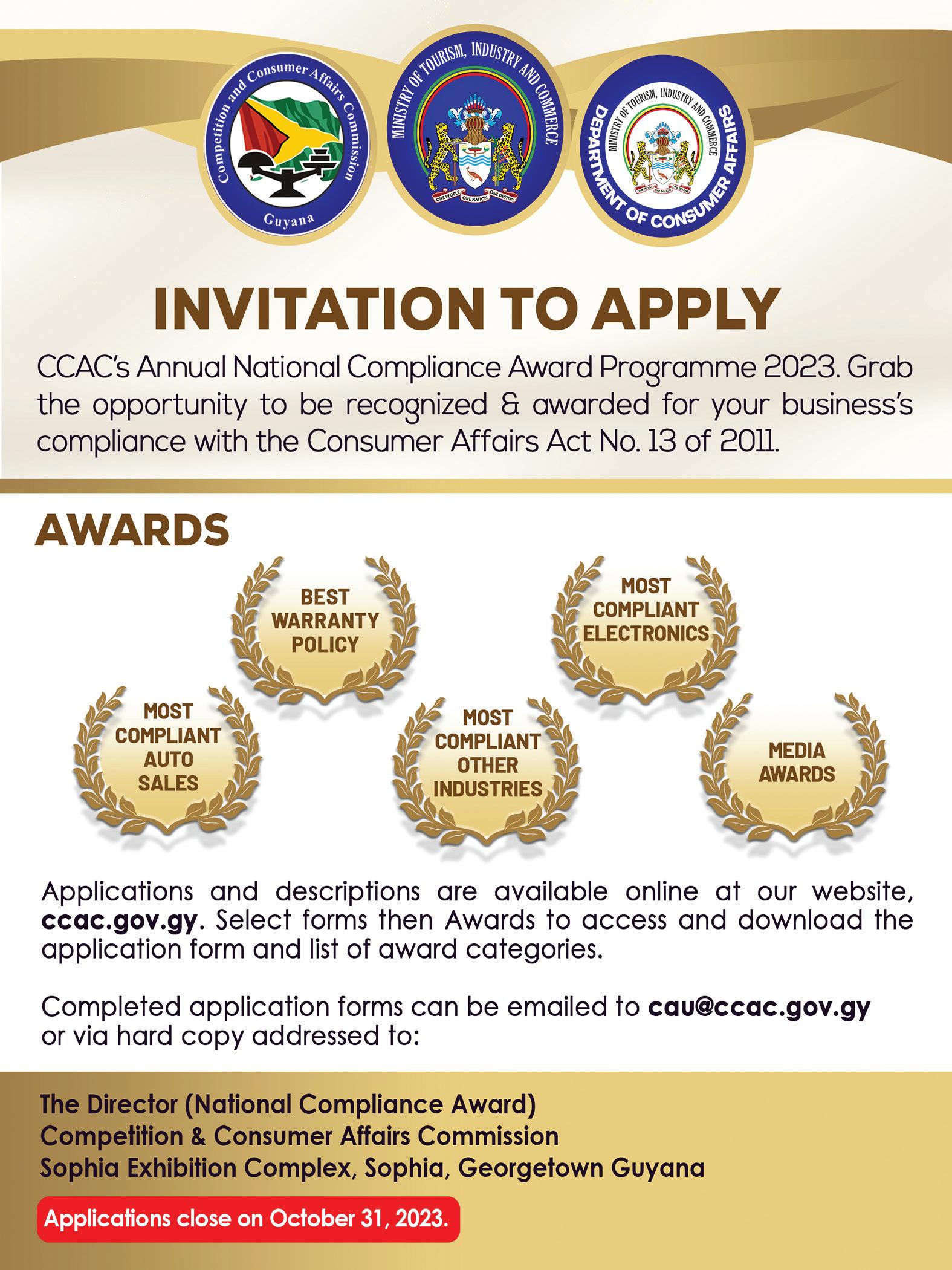


Seven Spiritual Laws of Success
SEVEN is my favourite number, and I will be engaging in seven meaningful events that will add value to people to assist them to end this year strong, and prepare them for a blessed and productive 2024. Some of these events are: Outside of Fear for Cancer Survivors, The Model Image Fashioning the Future You, The profit Profit, Makin Style etc.
A couple of weeks ago, we discussed the seven spheres of wealth, and it resonated with a lot of people from the feedback received. Today we will start the discussion on the Seven Spiritual Laws of Success by Deepak Chopra. The Seven Spiritual Laws of Success, A Practical Guide to the Fulfillment of Your Dreams is a 1994 self-help, pocket-sized book by Deepak Chopra, published originally by New World Library, freely inspired in Hinduism and spiritualistic concepts, which preaches the idea that personal success is not the outcome of hard work, precise plans, or a driving ambition, but rather of understanding our basic nature as human beings, and how to follow the laws of nature. According to the book, everything we want can be created when we comprehend and apply these laws in our lives. These laws are:
The Law of Potentiality
The Law of Giving and Receiving
The Law of Karma
The Law of Least Effort
The Law of Intention and Desire
The Law of Detachment

The Law of Dharma
I will also share Chopra’s advice on how we can incorporate these laws on evening days.
SUNDAY
The Law of Potentiality
The source of all creation is pure consciousness, pure potentiality seeking expression from the unmanifest to the manifest. And when we realise that our true Self is one of pure potentiality, we align with the power that manifests everything in nature.
I will put the Law of Pure Potentiality into effect by committing to take the following steps:
I will get in touch with the field of pure potentiality by taking time each day to be silent, to just Be. I will also sit alone in silent meditation at least twice a day for approximately 30 minutes in the morning, and 30 minutes in the evening.
I will take time each day to commune with nature, and silently witness every living thing’s intelligence. I will sit silently and watch a sunset, listen to the sound of the ocean or a stream, or simply smell the scent of a flower. In the ecstasy of my own silence, and by communing with nature, I will enjoy the life throb of ages, the field of pure potentiality, and unbounded creativity.
I will practise non-judgment. I will begin my day with the statement, “Today, I shall judge nothing that occurs,” and throughout the day, I will remind myself not to judge.


MONDAY
The Law of Giving and Receiving
The universe operates through dynamic exchange. Giving and receiving are different aspects of the flow of energy in the universe. And in our willingness to give that which we seek, we keep the abundance of the universe circulating in our lives.
I will put the Law of Giving and Receiving into effect by committing to take the following steps:
I will bring them a gift wherever I go and whomever I encounter. The gift may be a compliment, a flower, or a prayer. Today, I will give something to everyone I come into contact with, and so I will begin circulating joy, wealth, and affluence in my life, and in the lives of others.
Today, I will gratefully receive all the gifts that life offers me. I will receive the gifts of nature: Sunlight, the sound of birds singing, spring showers, or the first snow of winter. I will also be open to receiving from others, whether it be in the form of a material gift, money, a compliment, or a prayer.
I will commit to keep wealth circulating in my life by giving and receiving life’s most precious gifts: The gifts of caring, affection, appreciation, and love. Whenever I meet someone, I will silently wish them happiness, joy, and laughter.
The Law of Karma
TUESDAY
I will put the Law of Karma into effect by committing to take the following steps:
Today I will witness the choices I make in each moment. And merely witnessing these choices, I will bring them to
fortable, I will plunge ahead with abandon. If the choice feels uncomfortable, I will pause and see the consequences of my action with my inner vision. This guidance will enable me to make spontaneously correct choices for myself, and for all those around me.
WEDNESDAY
The Law of Least Effort
Nature’s intelligence functions with effortless ease with carefreeness, harmony, and love. And when we harness the forces of harmony, joy, and love, we create success and good fortune with effortless ease.
I will put the Law of Least Effort into effect by making a commitment to take the following steps:
1. I will practise acceptance. Today I will accept people, situations, circumstances, and events as they occur. I will know that this moment is as it should be, because the whole universe is as it should be. I will not struggle against the whole universe by struggling against this moment. My acceptance is total and complete. I accept things as they are at this moment, not as I wish they were.
2. Having accepted things as they are, I will take responsibility for my situation and for all those events I see as problems. I know that taking responsibility means not blaming anyone or anything for my situation (and this includes myself). I also know that every problem is an opportunity in disguise, and this alertness to opportunities allows me to take this moment and transform it into a greater benefit.
my conscious awareness. I will know that the best way to prepare for any moment in the future is to be fully conscious in the present.
Whenever I make a choice, I will ask myself two questions: “What are the consequences of this choice that I’m making?” and “Will this choice bring fulfillment and happiness to me and those affected by this choice?”
I will then ask my heart for guidance and be guided by its message of comfort or discomfort. If the choice feels com-
3. Today my awareness will remain established in Defenselessness. I will relinquish the need to defend my point of view, and I will feel no need to persuade others to accept my point of view. I will remain open to all points of view and not be rigidly attached to any one of them.
I like reading different material and even if I don’t agree with all the content, we can utilise the info that is aligned with our assignment. Next week we will discuss the remaining three laws. If you are interested in any of the events I mentioned above, please what be or email livingwithintention11@gmail.com as we continue the celebrate this beautiful journey called life BEYOND THE RUNWAY.
Melanie’s next Generation and the ...
FROM PAGE VIII
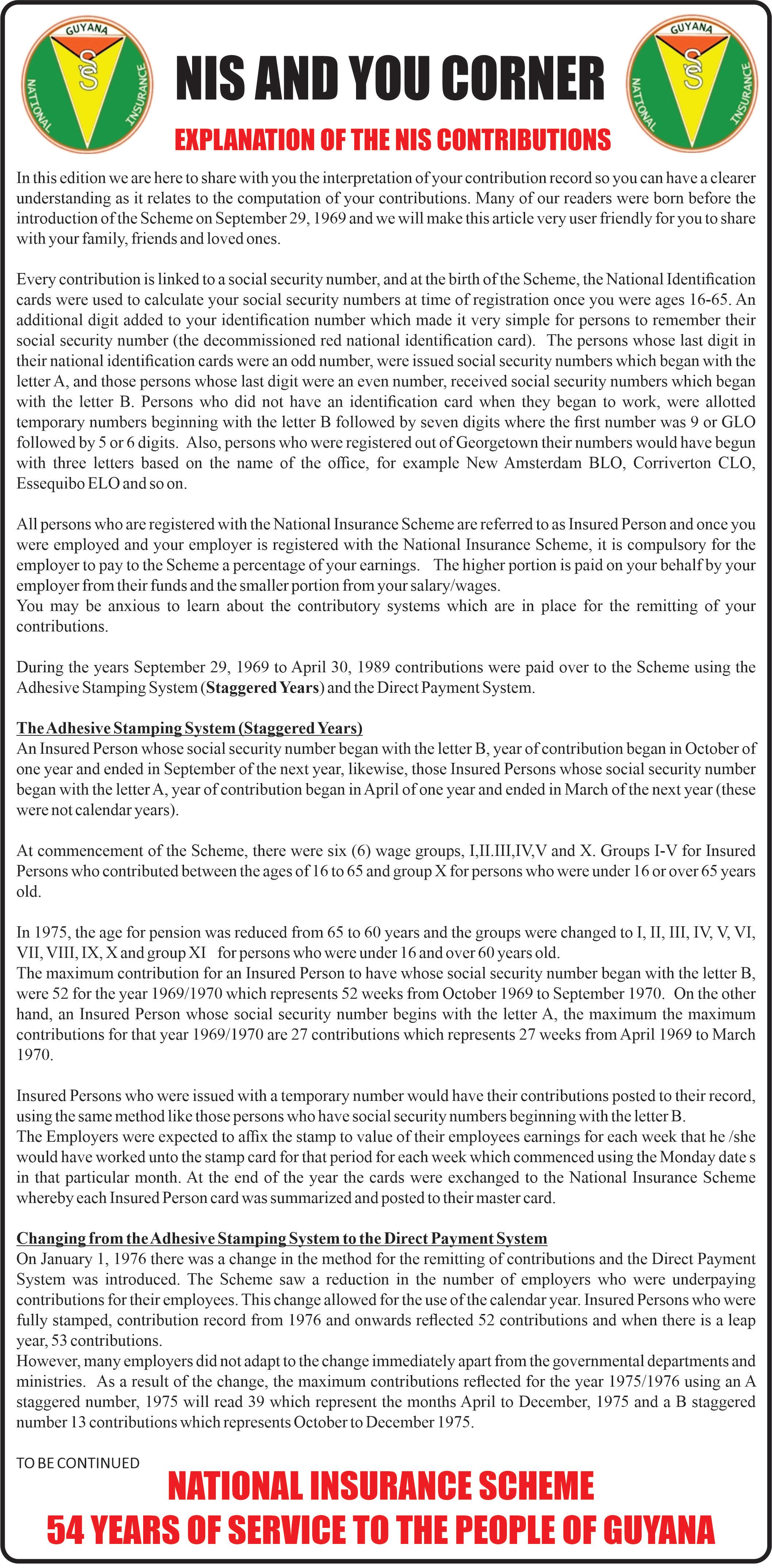
they need to come out and look at [them].” Sherwin expressed.
He went on to emphasise that, the task of cleaning up Melanie is by no means an impossible one, saying “Our plaza can be cleaned up; the
self-help crew needs to come out and do it……”
Sherwin further shared that it is the responsibility of the people to band together to care for the place they love, value and call home. “We, the people, can get strong and work together to get it clean; I am here. I will be the first to be the person who is going to start it,” he said.
In the past, Sherwin remembers how Melanie’s collaborative efforts would be implemented with every home offering a family member to work towards the development of the village. “One member from each home used to come out. We never had all this bush growing about, the drains stagnant. We never had that. We need Melanie people to get back to the frame that they come from,” he said.
Sherwin says that he has seen some steps being made to have the young people play a larger role in the village. He stated that, “For the previous location government election, I saw some young men get up and went out there. Because they need to be in the co-op. Because the old people aren’t coming out.” The vision of Melanie that Forbes Burnham had put forward, like in various other housing communities of the time, was that of a picturesque and peaceful suburban paradise.
As Sherwin said, “Burnham used to come himself.” He further stated, “He, Burnham, would share out books and pencils. And then he would tell you how to keep the community in order. “As time went on, Melanie went through a change, one where Sherwin says the village’s residents became less cooperative, where the people no longer banded together as they did, and wherein Melanie lost its sense of community. “You found that the community started to break up instead of build-up, and that is why our community is looking like this today.” Sherwin passionately expressed. The very name of Melanie, the word Damishana, means village. And there are still very few places that feel as authentically village among changes as Melanie does, with its neighbourhood shops around every corner, it’s young men playing football in the streets and the friendly women always offering a smile. Melanie is more than a village; it has become a family. Sherwin loves his village and holds it in high regard as the place that accepted and shaped him. And his message to his fellow villager and country men alike is simple. “We have to like and love where we are living. And we have to do better and I know it will be a better place,” he said.

‘Arts and Craft...
FROM PAGE V

the Amerindian way of life. Stoll is also a farmer of permanent crops, and pigs, and has been a part of all things Amerindian for the past 30 years, sharing his pieces with us since 1992.
He is known for his excellent pieces, labelled “Natives of the Forest”, and is seeking resources for his farm.
The father of four said he comes from a long line of artisans who have been making wooden craft.


PAULINE CHANCE, THE HANDICRAFT MAKER
Pauline Chance loves her heritage, and, annually, she would do whatever it takes to journey to the city to participate in the exhibition for Amerindian Heritage Month.
The 56-year-old is from Kabakaburi Misson, Region Two (Pomeroon-Supenaam), and she is the mother of nine with 13 grandchildren.
All her products are hand-made from tibiscri, nibbi, bamboo, feathers, beads, and other materials found within the environment or locally bought.

Chance told the Pepperpot Magazine that at age seven years old, she learned handicraft from her mother, and has been practising since to become an expert.
Today, her practice has paid off, and she makes beautiful pieces in the form of hammocks, bags, necklaces, hand bands, hats, purses, baskets and other decorative craft.
She has a family-owned small business in arts and craft, and the business will be registered. The prices are reasonable, considering the cost for the materials to make handicraft these days.
At the exhibition, she was supported by two of her daughters, Crystal and Wanita Chance, who were by her side to assist her in selling her products at the Sophia Exhibition Site.
Remembering a Priest and Patriot
THE recent death of Guyanese-born, New York-based catholic priest, Monsignor Paul Winston Jervis at age 69 has left thousands in the USA, Guyana and many other countries extremely saddened. Msgr. Paul Jervis was born in Georgetown on December 1, 1953. At age 19, he migrated to New York in the United States of America, where he spent the rest of his life. However, there was always a deep love for the land of his birth, and over the years, Fr. Jervis visited Guyana almost every year. There were times when his visits were more frequent, such as travelling to Guyana for special events in the Catholic Church, such as the ordination of a new priest or a bishop. When in Guyana, Monsignor would always visit the Parish of St. Pius X, where he was attached before he migrated.
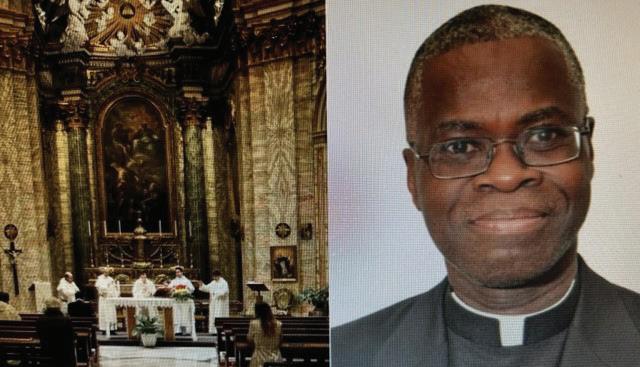
Not long after his arrival in the United States, he got the calling to the priesthood. That led to some years of studies, after which he was ordained in 1963. During the 40 years of his ministry, Msgr. Paul Jervis served in several parishes in Brooklyn and Queens. They include St. Francis of Assisi, St. Blaise, Holy Rosary, Our Lady of Victory, and St. Peter Claver, the Patron Saint of Slaves, African Missions and in-
terracial justice. During his 40 years in the priesthood, Msgr. Paul Jervis constantly spoke of and worked tirelessly for racial harmony wherever he went, and observed the need for such advocacy. When his own country, Guyana, descended into open racial conflicts, he established the Guyanese Holy Mass at his parish in New York to pray for peace in Guyana, and to send financial offerings to Guyana for specific projects. Over the years, part of that money has financed the Soup Kitchen at the Brickdam Presbytery. Dozens of destitute persons receive warm meals at that facility on a daily basis. For most or all of them, it is a means of avoiding starvation. Msgr. Jervis established what is known as the Guyanese Mass Committee, which is made up primarily of former altar boys of the Brickdam Cathedral in Georgetown. Most are now men in their mature years, but serve with youthful dedication. Most of them also visit Guyana regularly, and see first-hand how the soup kitchen operates. Msgr. Jervis has, on his many visits to Guyana, also seen for himself how the financial assistance sent by the Guyanese Catholic community in New York works.

Over his 40 years serving the Catholic Communities in Brooklyn and Queens, he was in regular contact with Guyanese who lived in those two boroughs of the city. His message of the need for racial unity was constant. As
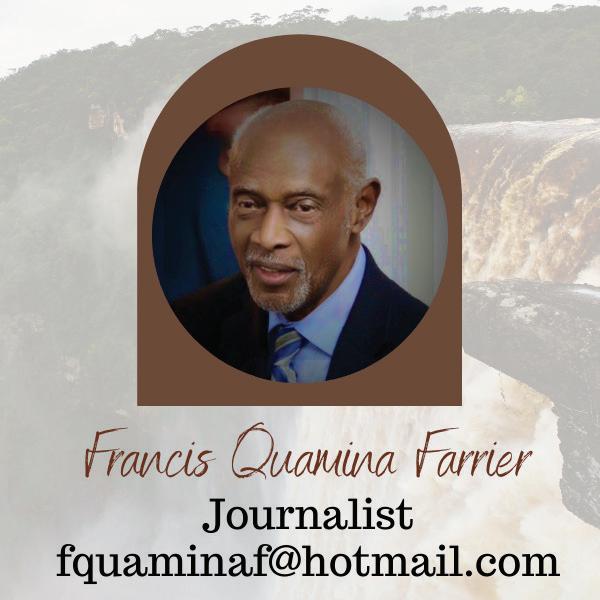
Commemorating the sacrifice of the ...
FROM PAGE X
an houses permitted a scrubbing of their homes with lemons every morning by enslaved women, which diffuses a beautiful odour, while he laments the following: “I scarcely ever saw a hand basin in any of their houses, even where there are white females.” What could have prevented the launch of scent-pleasing disinfectants not much later?
As we commemorate the ‘MAAFA’, we must recognise that the guilty of the slave trade were both self-centered Africans and Europeans. As Ottabah Cugoano published in his memoirs in 1787, he was a Fanti slave who was kidnapped as a child and sold at a European fort for a musket, lead, and clothes. He concluded himself to be a victim of both purchaser and seller. See: (History of Slavery By Susanne Everett). What tips that balance in the factor of that conclusion is the duration of the yoke upon the slave, and his generations, enabling the foundation through his generations of economic empires, while subject to the creation of himself as a ‘colonial’; a status of self-denial, self-contempt, and ‘Timeline forgetfulness’.
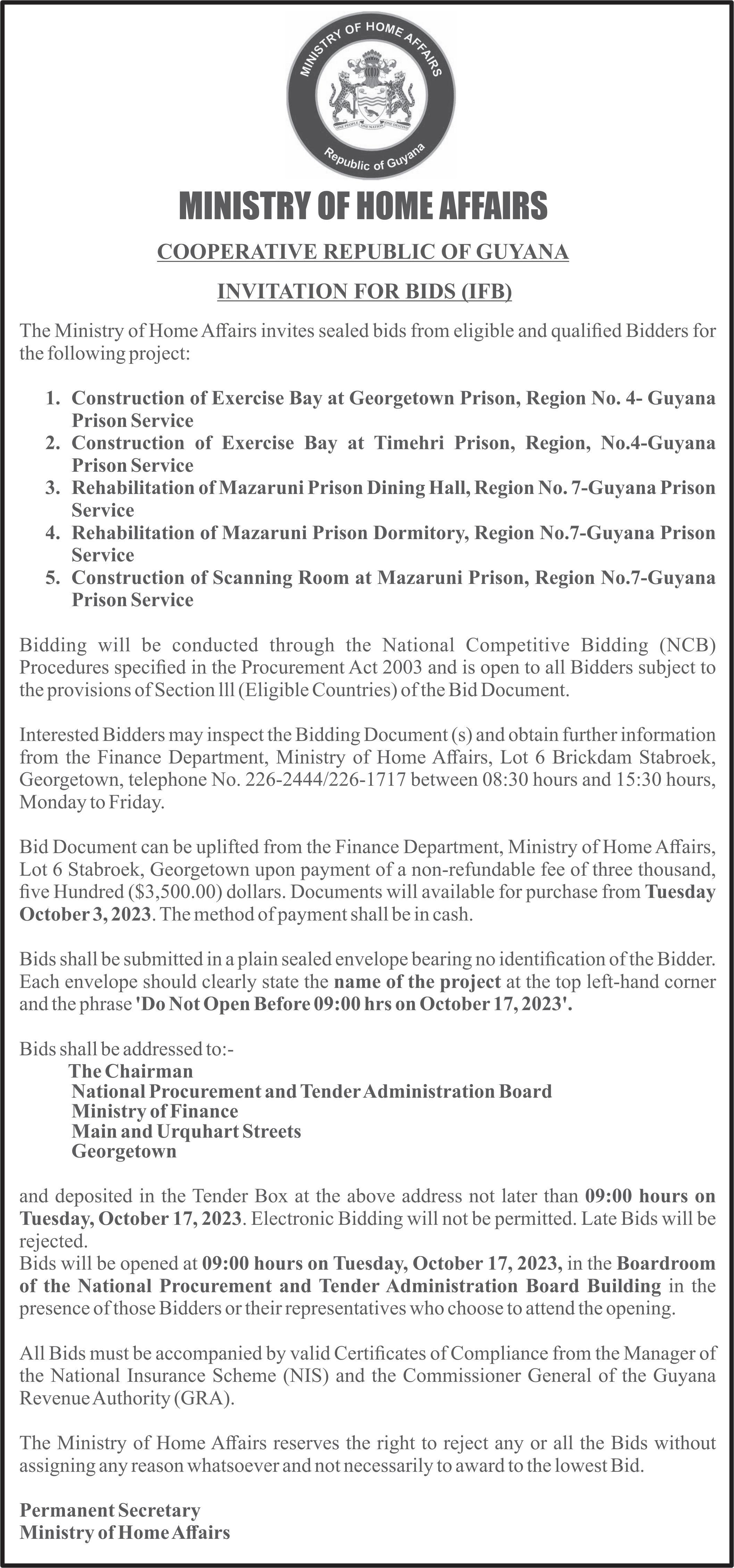
Let MAAFA, on October 12, on the seawall be an experience of awareness, addressing what has been paid for what must be partaken in. With what transpired, this article could not deal with the horrors of the journey in detail. That inquiry must also embrace a sober perspective of worlds we must all come to understand, perhaps emotionally at first, but then return to the sobriety of rational persistence resulting from the awakening of a long sleep.
Remembering a Priest...
FROM PAGE XXII
such, he earned the unofficial title of “Champion for Racial Harmony”. A first cousin of former Guyanese President, Hon. Samuel Hinds, Msgr. Jervis has, over the years, preached and prayed for a more racially united Guyana.. Observing the racial diversity of the congregations at the New York Guyanese Masses over the years, it would be safe to say that Monsignor Paul Jervis had achieved what he desired, in terms of racial unity among Guyanese. Added to the construction of a new church in his Parish of St. Peter Claver in Bedford Stuyvesant, he also spent many months researching and interviewing older parishioners about the life of Monsignor Bernard Quinn. The result was his book, “QUINTIENTIAL PRIEST - The Life of Monsignor Bernard Quinn. Guyanese, both Catholics and non-Catholics, who have heard of Msgr. Paul Jervis or read his book, recognise that he was someone all Guyanese can be proud of, and mourn his recent passing.















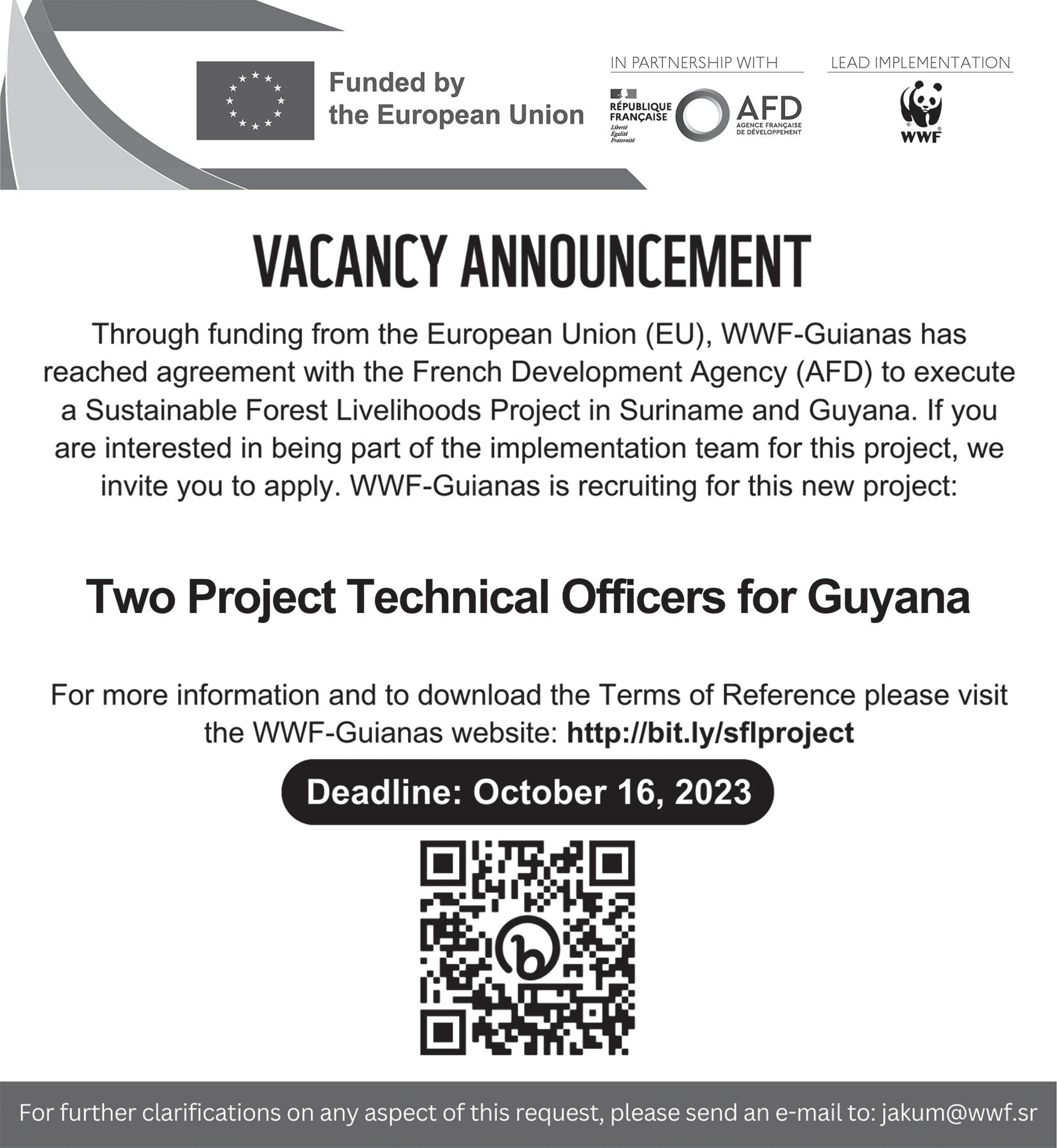






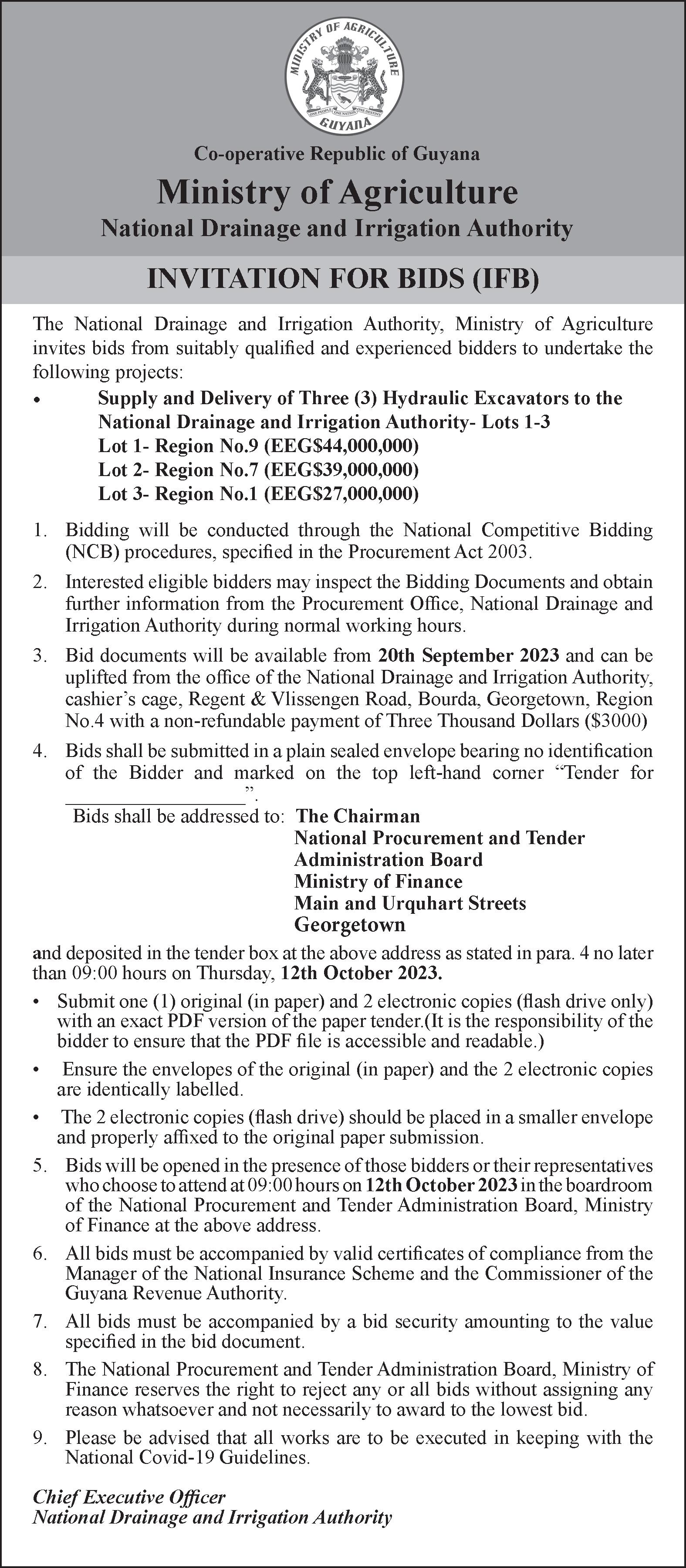




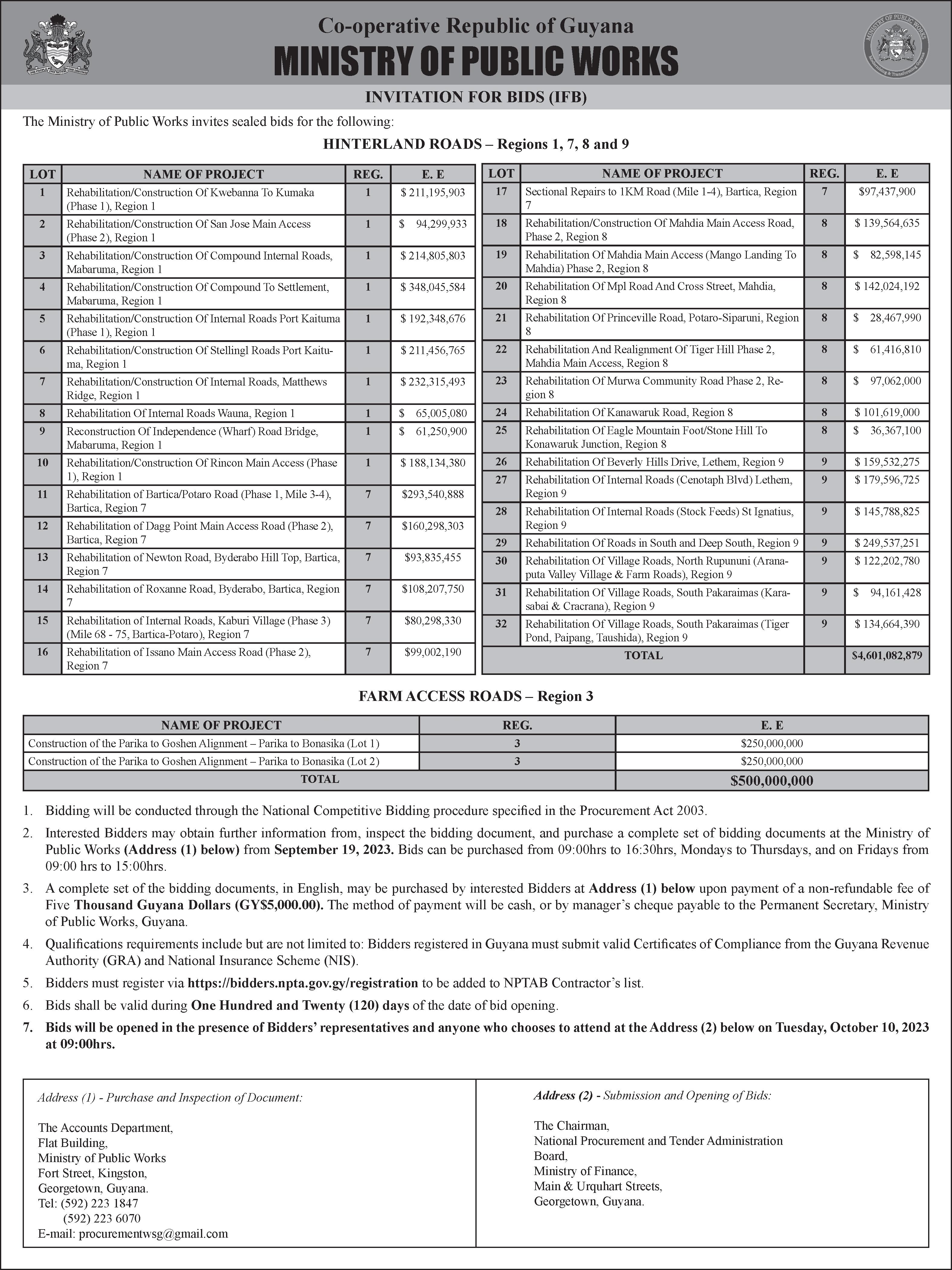
THOUGHT FOR TODAY
STUDY SUCCESS
Dear Student, Welcome dear friend. It is said that many people turn to fiction when they are alone, are lonely, and are ha-
October 8, 2023
bitual readers. Be a regular reader, too. Read everywhere you can safely do so - on a bus or at home, and a book is your constant companion. Reading helps to expand your knowledge and understanding of the world, improves cognitive function, reduces stress levels, increases empathy and creativity, and provides an escape from everyday life. Be wise.
Love you.
GRAMMAR Capitalisation
Capital letters make words distinctive. We continue to review capitalizing certain words.

a) Proper Adjectives. Because proper adjectives are derived from proper nouns, proper adjectives are also capitalized. For example: Chinese food African dialects French cuisine
However, certain common exceptions must be brought to your attention. Among them are venetian blinds, india ink, plaster of paris.
b) Headings. In headings and in titles of books and articles, capitalize the first and last words and all major words. Consider as major words all words except:
The articles ‘a,’ ‘an’ and ‘the.
How to Become an Avid Short Story Writer (Book title)
c) Special buildings and other man-made structures, ships, airplanes, and trains
the White House Eiffel Tower Caribbean Airlines
d) Holidays, special or famous events, historical periods or eras, famous documents
Labour Day the Dark Ages Christmas
e) Capitalize the first word and any nouns in the salutation of a letter, but capitalize only the first word of the complementary close.
Dear Mother, My dear Son and Daughter, Your old friend, Something to Do
Copy the following sentences. Supply capital letters where they are needed. Be ready to justify your use of capitals.
1. the clerk told me that the h. c. miller company sells more writewell pens than any other make.
2. the cape of good hope received its name from king john of portugal. It was first named “cape of storms” by bartolomeu dias, the first european to sail around it.
3. the exhibition included paintings by several mexican artists.
4. manufacturing developed in the north faster than in the south.
5. chinese and Japanese customs are referred to as oriental

customs.
6. the international harvester company specializes in farm implements.
7. columbus planned to sail west in order to reach the east.
8. paul edwards, jr., won first place in the poetry contest with his poem if wishes were horses.
READING IMPROVEMENT
Making Inferences while reading
Timely reminder: You make inferences when you use the information in a text to make logical assumptions about information that is not stated.
Reading skills and strategies:
a) Details in a story can be used as clues, or evidence, to infer unstated information.
b) Connections identified in a story can make inferences about the author’s meaning.
c) Recognising emotional appeals in texts enables the reader to define or mark connection to the author’s meaning.
What a), b) and -c) are saying is that details give the reader the basis to infer information that is not stated. For example, an author may not tell you directly how a character is feeling about an incident. Instead, he or she may give clues by describing what that character says and does during the occurrence. In the same way, an author may not directly state his or her message or theme. You can make inferences about the message based on events and outcomes that are directly stated.
Directions: Read the passage below. Then, answer the questions.
Across the aisle, a middle-aged man was staring out the bus window. A newspaper lay on his lap, but he wasn’t reading it. A cell phone rang nearby, and he jumped. He jiggled his foot, crossed and uncrossed his legs. He reached into his pocket, took out a map, and studied it. Then he glanced at his watch and smoothed back his hair. He peered eagerly out the window as the bus pulled into the station.
1. What fact does the writer tell you about the male passenger on the bus?
A He cares about his appearance.
B He is a middle-aged man.
C He likes to read.
D He doesn’t own a car.
2. Which fact gives a clue about the man’s state of mind?
A He is middle-aged.
B He is on the bus.
C He jiggled his feet.
D He takes out a map.
3. Which is the most logical inference about the man?
A He is cheerful. B He is nervous. C He is relaxed.
D He is unhappy.
4. What can you most logically infer from the man’s study of the map?
A He is arriving at an unfamiliar place.
B He is returning home.
C He travelled long-distance.
D He is not sure where the bus is heading.
5. What can you infer about his behaviour?
A He wishes the bus had gotten in earlier.
B He is expecting someone to meet him.
C He is making a new connection.
D He wishes he had not come.
For evil news rides post, while good news bates.
JOHN MILTON (1608-1674) Samson Agonistes (1671)
Preserving your teeth
IT has been more than twenty-nine years since I started this weekly column. In 1994, the column was named The Dentist Speaks and in my accompanying picture, I sported an afro hairstyle and a beard. Notwithstanding, over the years, my central theme generally remained the same.
From a philosophical standpoint, two very important facts must first be considered when contemplating oral health. The first fact concerns the role of the dental practitioner. While it is quite common for Guyanese to associate dentists with the extraction of teeth, the reality is that the dentist should be related to exactly the opposite, that is, with the preservation of teeth. So, persons should consider the conservation of their natural dentition as a matter of priority rather than taking the radical extraction approach which they could invariably regret.

The other critical point is that while the most common disease affecting mankind today is dental caries (tooth decay), it can hardly be expected that the number of dental personnel accessible to the public is adequate. Further, the cost of dental services universally is exorbitant, a reality that more than ever justifies every individual’s preventive approach to oral disease.
As a former senior administrator in the public sector, I can say that convincing the politicians who are responsible for appropriating funds for capital expenditure is no “walk in the park” as dental disease is not commonly given importance simply because no one dies from it.

Fortunately, it is theoretically possible to never visit the dentist and yet have a healthy mouth. Dental problems are

made simple because nearly all dental diseases originate from a single cause. That cause is known as bacterial or dental plaque. It is a sticky, transparent film formed by saliva itself and which covers the teeth. Special types of bacteria (germs) found in the mouth live in the plaque and feed on food remnants, especially sugar and starch.
The bacteria that inhabit the dental plaque convert sugar to acid as part of their digestive process. It is this acid that damages the enamel surface of the teeth when it is allowed to be exposed to it for more than 48 hours. What happens is that acid has the property of removing calcium from tissues. The hardness of teeth and bone is due to their high calcium content. Therefore, when the calcium is removed from the tooth surface, it becomes soft and pitted. This process continues and a cavity is formed. The cavity is called a carie.

You can recognise caries in your own mouth by checking on the surfaces for brown or chalky white spots. On the back teeth, called premolars and molars, the initial stage of decay appears as dark lines and patches occupying the fissures (grooves) and fossae (pits) of the occlusal (biting) surfaces of the teeth. The younger the person, the easier it is for the teeth to decay.
The most important aspect of oral health education is the effective control of plaque. Remember it is not how often you brush or floss that matters but how thorough you do so.

